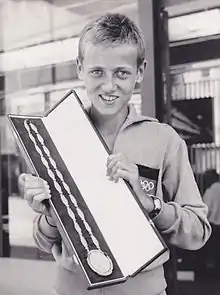| Men's coxed pair at the Games of the XVII Olympiad | ||||||||||
|---|---|---|---|---|---|---|---|---|---|---|
 Klaus Zerta, coxswain of the gold medal team | ||||||||||
| Venue | Lake Albano, | |||||||||
| Dates | 31 August – 3 September | |||||||||
| Competitors | 54 from 18 nations | |||||||||
| Winning time | 7:29.14 | |||||||||
| Medalists | ||||||||||
| ||||||||||
| Rowing at the 1960 Summer Olympics | |
|---|---|
 | |
| Single sculls | men |
| Double sculls | men |
| Coxless pair | men |
| Coxed pair | men |
| Coxless four | men |
| Coxed four | men |
| Eight | men |
The men's coxed pair competition at the 1960 Summer Olympics took place at took place at Lake Albano, Italy.[1] It was held from 31 August to 3 September.[2] There were 18 boats (54 competitors) from 18 nations, with each nation limited to a single boat in the event.[2] The three nations on the podium were the same as those in 1956, though in a different order (and with only 1 of the 9 individual competitors being the same). The event was won by the United Team of Germany (bronze in 1956), with Bernhard Knubel and Heinz Renneberg rowing with Klaus Zerta the coxswain. Zerta is the youngest confirmed male gold medalist in Olympic history at 13 years and 283 days, just beating Hans Bourquin (also in the men's coxed pair, in 1928) by 9 days.[3][4][5] The 1900 men's coxed pair gold-medal-winning coxswain may have been younger (estimates range from 7 to 12 years old), but the identities and ages of most coxswains in that event, including the gold medalist, are not known. The Soviet Union, bronze in 1956, took silver this time with Antanas Bagdonavičius, Zigmas Jukna, and Igor Rudakov. Defending champions the United States took bronze; Conn Findlay was the only man from the 1956 podium to return, this time with Richard Draeger as his rowing partner and Kent Mitchell the coxswain.
Background
This was the 10th appearance of the event. Rowing had been on the programme in 1896 but was cancelled due to bad weather. The men's coxed pair was one of the original four events in 1900, but was not held in 1904, 1908, or 1912. It returned to the programme after World War I and was held every Games from 1924 to 1992, when it (along with the men's coxed four) was replaced with the men's lightweight double sculls and men's lightweight coxless four.[2]
Only 1 of the 12 competitors from the 1956 coxed pair final returned: Conn Findlay from the gold-medal United States team. The United Team of Germany had been dominant the last few years other than their second-place finish to the Americans in the 1956 Games, winning four European championships with various crew compositions.[2]
Czechoslovakia, Romania, Spain, and Uruguay each made their debut in the event. The United States made its eighth appearance, matching the absent France for most among nations to that point.
Competition format
The coxed pair event featured three-person boats, with two rowers and a coxswain. It was a sweep rowing event, with the rowers each having one oar (and thus each rowing on one side). The course used the 2000 metres distance that became the Olympic standard in 1912 (with the exception of 1948).[6]
This rowing competition consisted of two main rounds (heats and final), as well as a repechage round that allowed teams that did not win their heats to advance to the final.
- Semifinals: Three heats. With 18 boats entered, there were six boats per heat. The winner of each heat advanced directly to the final; all other boats went to the repechage.
- Repechage: Three heats. With 15 boats racing in but not winning their initial heats, there were five boats per repechage heat. The top boat in each repechage heat advanced to the final, with the remaining boats eliminated.
- Final: The final consisted of the six boats that had won either the preliminary heats or the repechage heats.
Schedule
All times are Central European Time (UTC+1)
| Date | Time | Round |
|---|---|---|
| Wednesday, 31 August 1960 | 10:00 | Semifinals |
| Thursday, 1 September 1960 | 15:00 | Repechage |
| Saturday, 3 September 1960 | 16:30 | Final |
Results
Semifinals
Heat 1
| Rank | Rowers | Coxswain | Nation | Time | Notes |
|---|---|---|---|---|---|
| 1 | Igor Rudakov | 7:31.70 | Q | ||
| 2 | Kent Mitchell | 7:39.50 | R | ||
| 3 | František Staněk | 7:47.60 | R | ||
| 4 | Josip Bujas | 7:49.81 | R | ||
| 5 | Ken Lester | 7:55.59 | R | ||
| 6 | Ioannis Theodorakeas | 7:59.42 | R |
Heat 2
| Rank | Rowers | Coxswain | Nation | Time | Notes |
|---|---|---|---|---|---|
| 1 | Mircea Roger | 7:43.38 | Q | ||
| 2 | Jan Just Bos | 7:48.01 | R | ||
| 3 | Owe Lostad | 7:56.06 | R | ||
| 4 | Jorge Somlay | 8:02.36 | R | ||
| 5 | Joaquín del Real | 8:06.44 | R | ||
| – | Gyula Lengyel | DSQ | R |
Heat 3
| Rank | Rowers | Coxswain | Nation | Time | Notes |
|---|---|---|---|---|---|
| 1 | Klaus Zerta | 7:31.64 | Q | ||
| 2 | Sven Lysholt Hansen | 7:36.04 | R | ||
| 3 | Raúl Torrieri | 7:38.17 | R | ||
| 4 | Ian Johnston | 7:49.06 | R | ||
| 5 | Vincenzo Bruno | 8:09.20 | R | ||
| 6 | Étienne Pollet | 8:14.40 | R |
Repechage
Repechage heat 1
| Rank | Rowers | Coxswain | Nation | Time | Notes |
|---|---|---|---|---|---|
| 1 | Kent Mitchell | 7:39.00 | Q | ||
| 2 | Raúl Torrieri | 7:45.02 | |||
| 3 | Jorge Somlay | 7:59.33 | |||
| 4 | Joaquín del Real | 8:04.63 | |||
| 5 | Étienne Pollet | 8:18.29 |
Repechage heat 2
| Rank | Rowers | Coxswain | Nation | Time | Notes |
|---|---|---|---|---|---|
| 1 | Vincenzo Bruno | 7:39.52 | Q | ||
| 2 | František Staněk | 7:40.98 | |||
| 3 | Jan Just Bos | 7:42.15 | |||
| 4 | Ian Johnston | 7:47.82 | |||
| 5 | Ioannis Theodorakeas | 7:54.75 |
Repechage heat 3
| Rank | Rowers | Coxswain | Nation | Time | Notes |
|---|---|---|---|---|---|
| 1 | Sven Lysholt Hansen | 7:39.70 | Q | ||
| 2 | Josip Bujas | 7:48.05 | |||
| 3 | Ken Lester | 7:49.01 | |||
| 4 | Owe Lostad | 7:50.77 | |||
| 5 | Gyula Lengyel | 8:01.35 |
Final
| Rank | Rowers | Coxswain | Nation | Time |
|---|---|---|---|---|
| Klaus Zerta | 7:29.14 | |||
| Igor Rudakov | 7:30.17 | |||
| Kent Mitchell | 7:34.58 | |||
| 4 | Sven Lysholt Hansen | 7:39.20 | ||
| 5 | Vincenzo Bruno | 7:40.92 | ||
| 6 | Mircea Roger | 7:49.57 |
Results summary
| Rank | Rowers | Coxswain | Nation | Semifinals | Repechage | Final |
|---|---|---|---|---|---|---|
| Klaus Zerta | 7:31.64 | Bye | 7:29.14 | |||
| Igor Rudakov | 7:31.70 | Bye | 7:30.17 | |||
| Kent Mitchell | 7:39.50 | 7:39.00 | 7:34.58 | |||
| 4 | Sven Lysholt Hansen | 7:36.04 | 7:39.70 | 7:39.20 | ||
| 5 | Vincenzo Bruno | 8:09.20 | 7:39.52 | 7:40.92 | ||
| 6 | Mircea Roger | 7:43.38 | Bye | 7:49.57 | ||
| 7 | František Staněk | 7:47.60 | 7:40.98 | Did not advance | ||
| 8 | Jan Just Bos | 7:48.01 | 7:42.15 | |||
| 9 | Raúl Torrieri | 7:38.17 | 7:45.02 | |||
| 10 | Ian Johnston | 7:49.06 | 7:47.82 | |||
| 11 | Josip Bujas | 7:49.81 | 7:48.05 | |||
| 12 | Ken Lester | 7:55.59 | 7:49.01 | |||
| 13 | Owe Lostad | 7:56.06 | 7:50.77 | |||
| 14 | Ioannis Theodorakeas | 7:59.42 | 7:54.75 | |||
| 15 | Jorge Somlay | 8:02.36 | 7:59.33 | |||
| 16 | Gyula Lengyel | DSQ | 8:01.35 | |||
| 17 | Joaquín del Real | 8:06.44 | 8:04.63 | |||
| 18 | Étienne Pollet | 8:14.40 | 8:18.29 |
References
- ↑ "Rowing at the 1960 Rome Summer Games: Men's Coxed Pairs". Sports Reference. Archived from the original on 18 April 2020. Retrieved 12 August 2018.
- 1 2 3 4 "Coxed Pairs, Men". Olympedia. Retrieved 7 May 2021.
- ↑ "Oldest and Youngest Olympians (Summer Games)". 8 April 2021. Retrieved 7 May 2021.
- ↑ "Hans Bourquin". Olympedia. Retrieved 7 May 2021.
- ↑ "Klaus Zerta". Olympedia. Retrieved 7 May 2021.
- ↑ "Why Do We Race 2000m? The History Behind the Distance". World Rowing. 1 May 2017. Retrieved 19 April 2021.